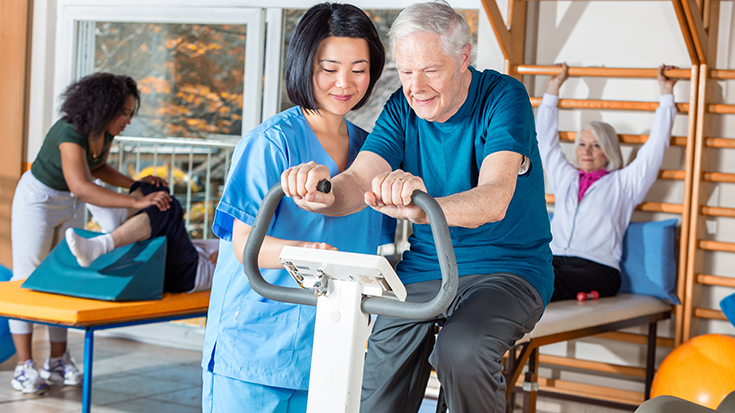
Pulmonary Rehabilitation (PR) programs provide an added network of support and care for patients. AARC members Debbie Koehl MS, RRT-NPS, FAARC, and Trina Limberg, BS, RRT, FAARC, MAACVPR, share their suggestions for running a successful program.
PR improves quality of life
“The greatest benefit of a successfully-run PR program is that we take care of the patients and their pulmonary needs,” Koehl said. “Not only do they improve their quality of life through exercise and improved endurance, but we also improve their outlook thru disease management strategies with our education program.”
For Koehl, a PR program can be a “one-stop-shop for patients.”
“We can help them understand everything that it takes to improve their quality of life,” she said.
According to Koehl, PR includes:
- Sharing medication knowledge
- Assessing oxygen and getting the patient the right oxygen equipment
- Helping patients communicate and partner with their physicians and family members
- Answering patient questions and providing support
“It is a place where the patient should feel comfortable with their disease process and know that they will be taken care of when they are at the program,” Koehl said.
Koehl’s Tips for a successful PR program
- Find the right staff – They need to be empathic, good patient care educators, and great clinicians.
- Know your stuff – Be the knowledgeable program coordinator/manger/director so that you can manage the program and keep it successful. Know the ins and outs of billing, insurance, coding and who you need to know in your hospital system.
- Find a physician champion – This person will help you with other medical staff, patient recruitment, and be one of your biggest advocates.
- Know where to recruit your patients – Recruit not only in your hospital system, but other hospital systems that may not offer a PR program. Make the referral process easy and keep lines of communication open.
- Be a member of your professional associations – Networking is key. It keeps you in the loop of what is happening and allows you to expand your knowledge and resources.
- Also, make PR fun! – It’s work for patients’ to breathe and exercise at the same time. Humor helps with depression and anxiety, so make this exercise fun for the patient. Keep your staff and your patients laughing. Find ways to celebrate things, holidays, birthdays or just because it’s a Monday!
PR empowers your patients
According to Limberg, the PR evidence shows improved outcomes of dyspnea, muscle fatigue and quality of life.
“Respiratory therapists help patients to regain their confidence,” Limberg said, “and improve their knowledge skills and abilities to manage their disease and symptoms.”
She continued to note that PR programs provide peer-to-peer interaction and support for patients as well as their families and caregivers.
“Pulmonary rehab specialists offer techniques and skills to help patients act early when an exacerbation is starting and to voice their needs to their providers,” Limberg said. “This level of support exemplifies patient empowerment.”
Limberg’s Tips for a successful PR program
- Know the clinical and CMS regulatory guidelines well so you can develop your charge master, expand referral sources and add value to your organization.
- Monitor your program metrics constantly such as clinic visit volumes, appointment types, billable volumes and revenue, indirect labor requirements, FTEs and the need to flex staffing with changes in volume. Listen to patient feedback and use it to elevate your team and service line.
- Take care of your team. Invest in their continued education with respect to case management, assessing complex patients and developing advanced practitioner skills. Reclassify and reward for performance.
- Know every aspect of your business better than your boss. Be a resource to him or her by knowing not only your departments profit and loss statement but what goes into the reports and point out where you think your opportunities lie in the future.
- Get involved in a professional organization to stay connected and abreast of clinical advancements and as a leader in a rapidly changing industry.
Keep the conversation going
What are your tips for running a successful PR program? Share your ideas at AARConnect.
Email newsroom@aarc.org with questions or comments, we’d love to hear from you.
















